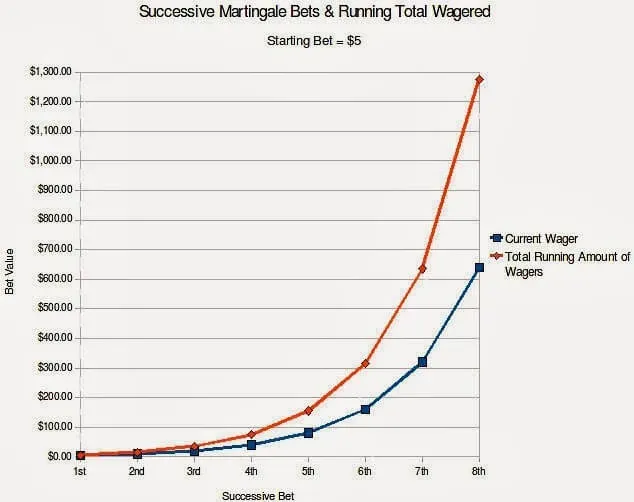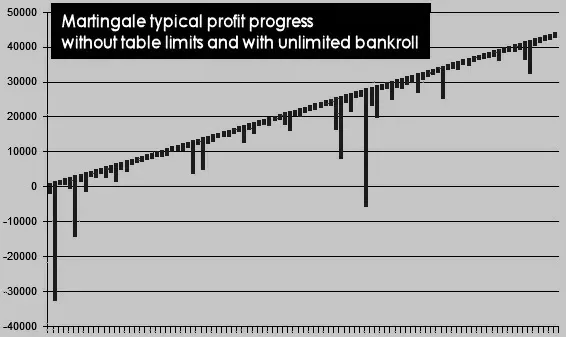
The Martingale is the most famous of all roulette systems and the epitome of positive progressions. It can be described in five words: double up until you win. It is designed for the Even Chances (Red-Black, High-Low, Odd-Even). On one hand there are sites that will present it to you as the magic way to win and on the other hand, in roulette forums there are people who will tell you that this is the surest way to ruin. The truth is somewhere in between. Martingale is an ingenious system with a weak spot.
The main concept behind this system is that at some point you will win, and this win will recover all your previous losses plus one unit. The idea is simple and solid. You will indeed win at some point, betting on the even chances (Red-Black, Odd-Even, High-Low). The problem is that this win, in some cases, could take too long. And in the rare event that it will take too long, you will be out of money to bet or you will have reached the table limits and not allowed to bet the needed amount. In short, Martingale is the best system to use if there were no table limits and if you had unlimited bankroll. These are unrealistic conditions though.
| spin | BET | OUTCOME | TOTAL PROFIT |
| 1 | 1 | LOSS | -1 |
| 2 | 2 | LOSS | -3 |
| 3 | 4 | LOSS | -7 |
| 4 | 8 | LOSS | -15 |
| 5 | 16 | LOSS | -31 |
| 6 | 32 | WIN | 1 |
| 7 | 1 | LOSS | -0 |
| 8 | 2 | LOSS | -2 |
| 9 | 4 | LOSS | -6 |
| 10 | 8 | LOSS | -14 |
| 11 | 16 | LOSS | -30 |
| 12 | 32 | LOSS | -62 |
| 13 | 64 | WIN | 2 |
| 14 | 1 | LOSS | 1 |
| 15 | 2 | LOSS | -1 |
| 16 | 4 | LOSS | -5 |
| 17 | 8 | WIN | 3 |
After 14 losses and just 3 wins we are at 3 units profit. Amazing! What other progression could have achieved that?
At first sight, Martingale seems a great and quite innocent system, but if you do some analysis you will realize it is a very risky strategy. The secret is the effect of doubling up. By continuously doubling up you can reach extremely high bets, you cannot afford. For example, if you start by betting $5, after 7 lost bets your 8th bet should be $640.

The following table shows how fast your bets and losses can increase by using Martingale. In the far right column you see the probabilities of the respective consecutive losses.
| spin | BET (units) | OUTCOME | TOTAL PROFIT | PROBABILITY (%) |
| 1 | 1 | LOSS | -1 | 51,4 |
| 2 | 2 | LOSS | -3 | 25,7 |
| 3 | 4 | LOSS | -7 | 12,8 |
| 4 | 8 | LOSS | -15 | 6,4 |
| 5 | 16 | LOSS | -31 | 3,2 |
| 6 | 32 | LOSS | -63 | 1,6 |
| 7 | 64 | LOSS | -127 | 0,8 |
| 8 | 128 | LOSS | -255 | 0,4 |
| 9 | 256 | LOSS | -511 | 0,2 |
| 10 | 512 | LOSS | -1023 | 0,1 |
| 11 | 1024 | LOSS | -2047 | 0,05 |
| 12 | 2048 | LOSS | -4097 | 0,025 |
| 13 | 4098 | WIN | 1 |
The probabilities of 10 consecutive losses is roughly 0,1% or 1 in 1000 times. This means that out of 1000 spin series with one win (after the win we start a new series) there will be a spin series, in which the win will come after 10 consecutive losses. This is not common but not impossible. And you never know when that really bad sequence will come. It may come well before the other 999 sequences. It can happen whenever it wants! Even a 12 or 15 consecutive losses sequence can happen, these kinds of streaks though uncommon are to be expected at some point.
By the tenth lost spin we would have lost over 1023 times our initial bet. This means that if we started with 10 euros we have lost more than 10,000! But most probably we would have reached the table limit even before the 10th bet, since in most casinos the table limit is 300 times the minimum bet and at the 10th bet we should bet 512 units.
What is the longest streak for Red, Black, Odd, Even, High and Low?
The short answer to this question is: 30 consecutive appearances.
Tommaso Dorigo run 10.000.000 times a simulation of 200 spins (2 billion spins in total) and came up with this interesting graph about the distribution of the longest streaks in Even Chances.
We see that there was never a streak longer than 30 and the average losing streak in 200 spins was around 7 spins.

The distribution of the longest losing streaks for even chances in 200 spins.
The horizontal axis shows the longest streaks and the Vertical axis shows in how many 200 spins tests they happened.
Like most negative (up as you lose) progressions, the martingale can not take advantage of series of wins. In case of winning streaks you start over and over winning just one unit again and again.
Kavouras
One unfair criticism I hear sometimes about the Martingale is “why risk so many units just to win one unit?”. They refer to the fact that you can reach a very high bet in order to regain your losses and gain one unit profit. This is an illogical criticism. Every bet has the same 2 to 1 payoff. No matter how much you bet, you can win or lose that amount. That holds true for Martingale and for any other (even chances) system. But people often look at the high bets of the Martingale and mentally they add all the previous losses, so they absurdly conclude that “you risk many units just to win one unit”. But you can look at this in the opposite direction and ask yourself “what other system has the ability to regain ALL previous losses with just one win?”. Answer: None. Do not underestimate the Martingale and do not dismiss it for the wrong reasons.
1. It can overcome an overall bad distribution of outcomes. Just one single win is enough to produce a profit.
2. Theoretically (ignoring bankroll and table limits) it is indeed a sure winning method.
Disadvantages
1. Doesn’t take great advantage of series of wins (winning streaks).
2. You need the guts to make big bets.
3. A long series of losses can deplete your bankroll or reach the table limits.
Modifications
For a system like this, it seems an obvious modification to add some sort of “stop loss” parameter. And this is indeed a very good idea. Keep in mind however that Stop Loss is not panacea and there is always a trade off. Stop loss limits your losses, but it also limits your wins. Many times the next bet, which the stop loss will prevent you from making, would have been a winning bet. Anyway, a simple and effective variation of the Martingale is the 4-step Martingale, in which we are allowed to double our bets only tree times: 1-2-4-8. The 4-step Martingale will win roughly 15 out of 16 times (93% win rate). The wins will gain us 1 unit each, while a loss will take us 15 units back.
(unfavorable sequence)
| spin | BET | OUTCOME | TOTAL PROFIT |
| 1 | 1 | LOSS | -1 |
| 2 | 2 | LOSS | -3 |
| 3 | 4 | LOSS | -7 |
| 4 | 8 | LOSS | -15 |
| 5 | 1 | LOSS | -16 |
| 6 | 2 | WIN | -14 |
| 7 | 1 | LOSS | -15 |
| 8 | 2 | LOSS | -17 |
| 9 | 4 | LOSS | -21 |
| 10 | 8 | LOSS | -29 |
| 11 | 1 | WIN | -28 |
| 12 | 1 | WIN | -27 |
| 13 | 2 | LOSS | -29 |
| 14 | 4 | WIN | -25 |
| 15 | 1 | WIN | -24 |
| 16 | 1 | LOSS | -25 |
| 17 | 2 | WIN | -23 |
In 17 spins with 6 wins and 11 losses we are at -23 units. That’s bad. And this is because we faces two losing streaks longer than 3. This system is vulnerable to long losing sequences. Notice that if we used a 6-step Martingale (1-2-4-8-16-32) instead a 4-step, we would have been in profit. This also shows why “stop loss” is a double edged sword.
(many losses yet still profitable)
| spin | BET | OUTCOME | TOTAL PROFIT |
| 1 | 1 | LOSS | -1 |
| 2 | 2 | LOSS | -3 |
| 3 | 4 | WIN | 1 |
| 4 | 1 | LOSS | 0 |
| 5 | 2 | LOSS | -2 |
| 6 | 4 | WIN | 2 |
| 7 | 1 | LOSS | 1 |
| 8 | 2 | LOSS | -1 |
| 9 | 4 | WIN | 3 |
| 10 | 1 | LOSS | 2 |
| 11 | 2 | LOSS | 0 |
| 12 | 4 | LOSS | -4 |
| 13 | 8 | WIN | 4 |
| 14 | 1 | LOSS | 3 |
| 15 | 2 | LOSS | 1 |
| 16 | 4 | LOSS | -3 |
| 17 | 8 | WIN | 5 |
In 17 spins with only 5 wins and 12 losses we managed to stay ahead with 5 units profit. This is an excellent result that shows the strength of the 4-step Matingale, when there are no long losing streaks.
Grand Martingale
This is a more aggressive version of the Martingale, in which, when we lose we double up and add one extra unit. The progression looks like this: 1-3-7-15-31-63 etc. This is an even more riskier strategy than Martingale and I clearly suggest that you avoid it. It is simply not worth it.
